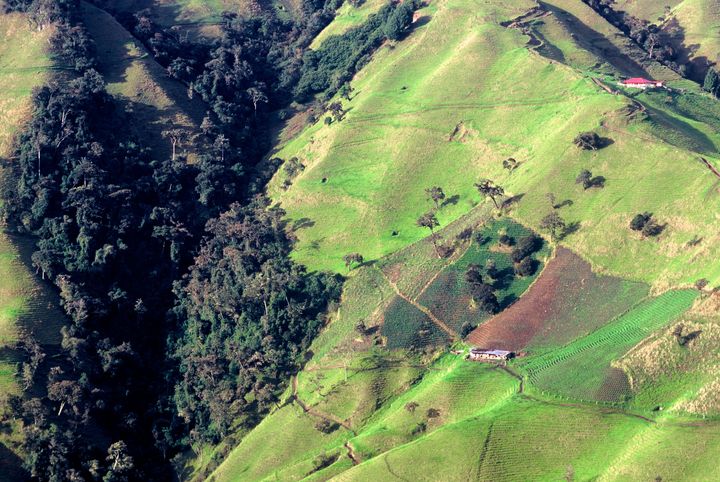
Business is now anything but usual, much less predictable. The world is changing at unprecedented rates. Constant investment in innovation and efficiency is no longer a luxury to ensure greater returns—it's a necessity to any business that hopes to keep up.
Some think of ‘business as usual’ as a straight line on a graph--the consistent output produced by consistent inputs. The more optimistic among us believe that business as usual actually results in slow and steady improvements in efficiency and productivity. Either way, the phrase brings to mind a relatively stable baseline, from which point we can make small changes in efficiency to increase productivity or to reduce key impacts. This suggests a boring but dependable status quo -- and the dependability of business as usual is why so many producers, especially in the food sector where profit margins can be razor thin, are reluctant to invest in change.
Unfortunately, that’s wrong. What we now understand is that business as usual is harder to maintain than we thought. It doesn’t just happen.
Consistent improvements and inputs over time no longer yield predictable, much less stable, increases in productivity. In fact, a few curves seem to be headed in the wrong direction. This is not only a wake up call for all those who believe in the inevitability of technological enhancements, but also those who believe that the human condition will automatically improve.
Business is now anything but usual, much less predictable. The world is changing at unprecedented rates. Constant investment in innovation and efficiency is no longer a luxury to ensure greater returns—it's a necessity to any business that hopes to keep up.
We are seeing increases in the overall use of water for food production globally and the shrinking of natural biodiversity as a result of conversion. This applies to natural habitats of all kinds—forests, arid lands, grasslands, wetlands, mangroves, coastal oceans, benthic areas and coral reefs. At the same time we are witnessing the expansion of toxic spaces like bleached reefs, red tides, and dead zones—places where, as the name suggests, nothing can survive.
This rapid change is a combination of several factors: climate change, population growth, technology, political instability, and the global nature of our supply chains. Just take a look at the world now as compared to the world in 1970: in that time human population doubled; non-human vertebrate species’ populations declined by an average of 58 percent; the global average temperature increased by about one degree Celsius. In 1970 the US imported about $54 billion worth of goods and services; in 2016 that number rose to $2.7 trillion.
In practical terms from a food perspective this means more people to feed on a hotter planet with not only fewer resources, but also poorer quality resources.
Farmers particularly are between a rock and a hard place: the impacts of climate change and weather variability are more pronounced, and where we are also now farming lands less suited to agriculture. This spells relative declines in productivity and efficiency. Just like a city needs to keep investing in aging roads and buildings to maintain a standard of living, we also need to invest in the infrastructure of life on Earth—soil, water, habitat, and air. We’re decades behind in this investment, and the consequences of neglect are becoming more and more apparent.
The cocoa industry is a good example of the changing landscape. Production of cocoa is no longer keeping up with demand, and the deficit could be as high as 2 million metric tons by 2030. The decline is the result of a perfect storm of factors. The trees themselves age and become less productive after 25 years or so. Thus, any tree planted before the 1990s, yields less than it once did.
And declining productivity means replanting, which in the best conditions takes 2-3 years to start producing. Replanting is compounded in places like Cote d’Ivoire where during la Nina years as many as 80% of seedlings die due to lack of moisture. There is also an aging workforce, and because income from cocoa farming is so low, there is no group of aspiring young people to take over. On top of this, half of the pods that set on a cocoa tree fall off before they are harvested.
The effort to keep production on pace despite decreasing yields is driving a boom of illegal activity--everything from deforestation and invasion of protected areas to increased use of child labor. We’re past unsustainable here; cocoa is broken. Too many of the key the trends-- productivity, producer income, child labor, malnutrition, age of producers, age of trees, cocoa diseases, pods never making it to maturity-- are headed in the wrong direction. The business as usual scenario here is headed in the wrong direction.
And it’s not just a local issue. As productivity and livelihoods decline, companies that rely on cocoa production will either have to innovate or die. Thankfully for the chocolate lovers among us, there is hope that companies will shift the paradigm.
The cocoa industry’s not alone. There are other commodities where the performance curves, stable for decades, are now moving in the wrong direction. Examples include declines in the productivity gains of most of the crops being grown; farmers in California who lost about $600 million last year because of drought; the spread of citrus greening disease globally and where in Florida alone it cost producers an estimated $4.5 billion in just five years; corn and soy yields in the US Midwest are expected to drop by 25 percent in the next 30 years due to climate change. But here is the most shocking map—one that projects that by 2050 Missouri and Iowa will be the center of US cotton production and no longer producing much soy or corn.
Forget maintaining the status quo; even basic survival is going to be tricky for most producers. These commodities are, like cocoa, also broken to varying degrees. It is time to fix them. We need to bend the performance curves and the trend lines in the right direction. A major first step is accepting the new reality: areas that were good for production of specific crops in the past are less viable today and will become even less so if the crops grown and the way they are grown are not changed to reflect the new conditions.
But the global nature of this crisis is also our greatest asset. With organization, education, and global cooperation, we can feed everyone on the planet. And in doing so, businesses willing to adapt and to invest in solutions will be better for it. That means not only diversifying and shifting production, but also investing in people and the environment.
We can start with basics--enforcing existing laws. Ensuring labor and environmental protection laws are followed is the right thing to do for obvious reasons, but this would also level the playing field. No more shortcuts to buoy up a failing system. We have heard a lot about how environmental externalities, the use of water, impact on soil, release of carbon, need to be reflected in pricing. But so do social externalities like illegality, including labor (slavery, bonded labor, child labor or undocumented workers) or governance (fraud or corruption).
From there, we have to work with and invest in producers to help them adapt to changing conditions. The cut-and-run approach to sourcing materials is not going to work in the long-run. We need to think more long-term: contracts to ensure farmers can rely on a stable, living wage so that they in turn will invest in the long-term health of their children and their land; education to help many transition to less-resource-intensive techniques or completely new crops better suited to warming climates; or, in extreme cases, new livelihoods altogether.
Changes at the farm level are only part of the equation. In order to keep pace with the rate of change, we need to ramp up global trade: produce surpluses in the places we can produce them best, and then trade globally. We need stable trade that we can rely on it to fill gaps caused by climate change, famine, war, or other disruptions. Every country will experience disruptions. How we anticipate them will be critical. In the current political climate of increased isolation, multinational corporations may be best-suited to address this reality.
Investment in research, education, and world politics--yes, this is way above and beyond what any company 50 years ago had to do to stay in the black. But like it or not, that’s the reality. WWF can no longer just work locally to create protected areas and work with different species to ensure biodiversity conservation. The world has changed and will continue to change. What it will take any organization to stay relevant in a world changing as fast as this one is innovation and picking up on signals faster than others. For those organizations that want to survive, the other option, business as usual, isn’t actually an option at all.
